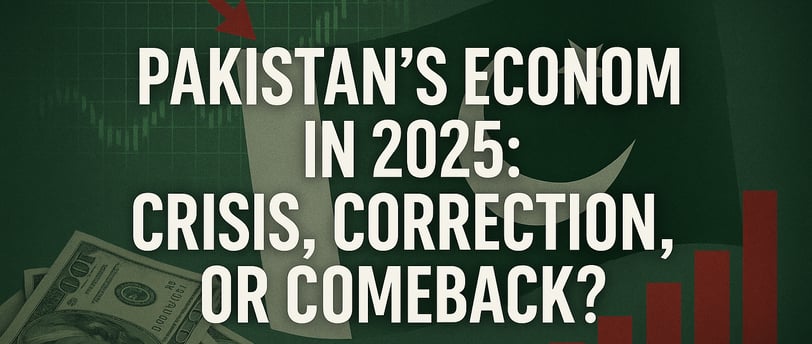
Pakistan’s Economy in 2025: Crisis, Correction, or Comeback?
Explore the true state of Pakistan’s economy after the 2022 regime change. From inflation and debt to tech growth and remittances, is recovery possible without structural reform?
ECONOMY & GOVERNANCE – PAKISTAN
6/7/20253 min read


As Pakistan moves through 2025, its economy is at a breaking point — or perhaps a turning point. Skyrocketing inflation, a volatile rupee, rising debt, and political instability continue to erode public confidence and investor trust.
Many experts argue that the current crisis was set in motion not just by global conditions, but by a series of internal decisions — most notably the regime change in April 2022, which sparked economic disarray that continues to ripple across the country.
Current Economic Overview
As of mid-2025, Pakistan’s economic snapshot looks like this:
Inflation rate: Around 25.2% (year-on-year)
Rupee exchange rate: PKR 308 per USD
Public debt: Over 75% of GDP, nearly PKR 70 trillion
Unemployment: Estimated at 9.1%
Foreign reserves: Hovering around $9.3 billion
Remittances: $28.7 billion expected in 2024–25
IT export revenue: Estimated $3.5 billion so far this fiscal year
These indicators reflect a nation under pressure — from external lenders, internal mismanagement, and mounting public frustration.
What Went Wrong After the 2022 Regime Change?
When Imran Khan’s elected government was removed via a no-confidence vote in April 2022, the aftermath brought more than just political drama. It deeply disrupted economic policy and institutional continuity.
1. Market Crash and Investor Panic
Within a week of the power shift, the KSE-100 index lost over 2,000 points. Foreign investors backed away, spooked by uncertainty and instability.
2. Rupee in Free Fall
The PKR plunged from 178/USD in early 2022 to over 240 within a year, and eventually to 308 in 2025. The devaluation made imports — fuel, food, medicine — vastly more expensive.
3. IMF Deal Breakdown and Harsh Austerity
The new government struggled to renegotiate with the IMF, leading to stricter loan conditions. Subsidies were slashed, taxes raised, and utility bills soared — triggering countrywide protests and labor strikes.
4. Industry Paralysis
Many small and medium industries shut down due to rising input costs, power outages, and unclear fiscal policies. Export sectors were hit hard, particularly textiles and manufacturing.
5. Infrastructure and CPEC Stagnation
Mega development projects under the China-Pakistan Economic Corridor (CPEC) were delayed or frozen. Public works and job programs halted, draining economic momentum.
6. Brain Drain and Youth Exodus
More than 800,000 skilled professionals, students, and laborers left the country between 2023 and 2024 — seeking better opportunities abroad. This loss of talent hurt Pakistan’s service, IT, and healthcare sectors.
Inflation and the Daily Struggle
In urban centers, the price of a 20kg wheat flour bag has crossed PKR 2,700. Power bills eat up nearly half of a middle-income family’s budget. Public transport, school fees, and groceries have all seen double-digit hikes.
Over 40% of Pakistan’s population now lives below the poverty line, with little access to affordable healthcare, clean water, or energy.
What’s Still Working in Pakistan’s Economy?
Despite the bleak outlook, some areas show resilience and even potential for recovery:
1. Tech & Freelance Economy
Pakistan’s digital workforce — especially freelancers — continues to generate billions. The country ranks in the top 5 globally for freelance earnings. Young developers, designers, and remote workers are sustaining families and boosting exports.
2. Agriculture Tech Reform
In some regions, smart irrigation, better seed distribution, and mobile farming apps have improved crop yields. While agriculture still lags in modernization, progress is evident in parts of Punjab and Sindh.
3. Remittance Support
Overseas Pakistanis remain a lifeline for the country. Annual remittances of nearly $29 billion help stabilize the current account, keep families afloat, and fund local consumption.
International Position & Challenges
IMF and FATF Compliance: Pakistan remains under strict fiscal supervision and must meet reform targets to unlock future aid.
CPEC Delays: Projects are being renegotiated but remain slow-moving.
Trade with India: Quiet discussions about reopening trade exist but have not materialized publicly.
Structural Issues Blocking Recovery
Elite Capture: Wealth and policy influence remain concentrated in the hands of a few families and unelected institutions. This prevents inclusive economic growth.
Judicial Weakness: Investors, both local and foreign, fear a lack of contract enforcement and political interference in legal matters.
No Export Diversification: Pakistan still depends on low-value exports like textiles. There’s been little progress in higher-value manufacturing, technology, or renewable energy.
Policy Instability: Governments change, but economic strategy rarely endures. This policy whiplash kills momentum and scares away investors.
What Lies Ahead?
The path forward is uncertain. Pakistan faces three broad possibilities:
1. Economic Recession
Continued instability and policy failure could deepen the crisis, risking food insecurity, unrest, and even sovereign default.
2. Prolonged Stagnation
Without reforms or consensus-building, the country may hover in economic limbo — not collapsing, but not growing either.
3. Gradual Recovery
If a stable government emerges, reforms are implemented, and trade opens with neighbors, there’s still a chance for long-term recovery.
Final Thoughts
Pakistan’s economic crisis didn’t begin overnight — and it won’t be fixed overnight. But one thing is clear: regime change in 2022 triggered a chain reaction that destabilized everything from currency markets to public morale.
To rebuild, Pakistan needs more than just foreign aid. It needs economic transparency, political accountability, judicial independence, and leadership that reflects the will of the people.
“Pakistan doesn’t just need economic stability — it needs systemic honesty.”
Disclaimer
This article is based on publicly available news sources and independent human rights reports. It is intended for informational and educational purposes only. The analysis herein does not allege or imply criminal misconduct by any individual. Interpretations are made in good faith to support public awareness, democratic discourse, and policy reflection.
Voice of Pakistani Americans
TOGETHER WE CAN DO IT!
Support
© 2025. All rights reserved.


